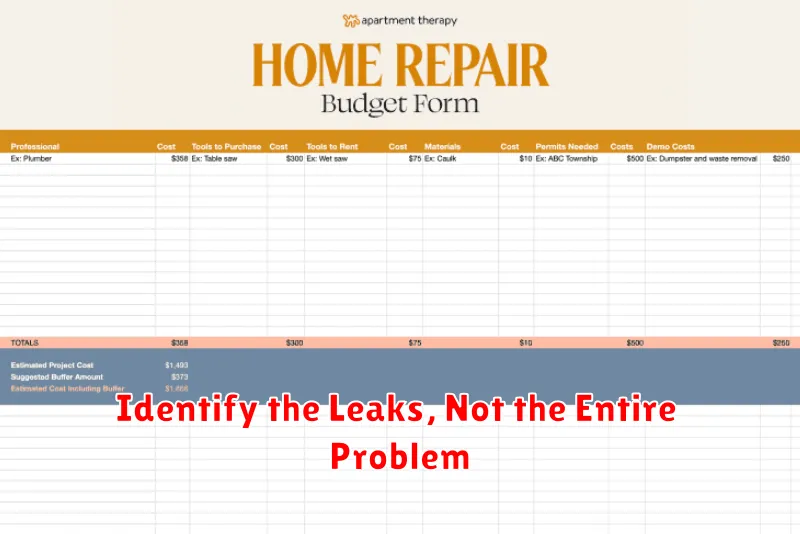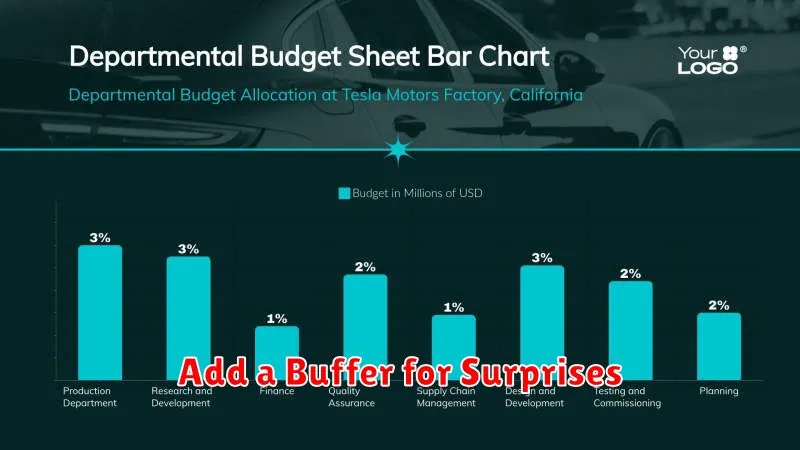Is your budget in shambles? Are you feeling overwhelmed by unexpected expenses and dwindling funds? You’re not alone. Many people experience setbacks with their budgets, but it doesn’t mean you need to start from scratch. This article provides a practical guide on how to fix a broken budget without the daunting task of completely rebuilding it. We’ll explore effective strategies to identify the root causes of your financial woes, implement immediate budget repair solutions, and establish sustainable financial habits for long-term success. Learn how to regain control of your finances and achieve your financial goals, even after a budgetary stumble.
Forget the all-or-nothing mentality. This comprehensive guide offers a step-by-step approach to budget recovery. We’ll cover crucial aspects like analyzing your spending, identifying areas for immediate cost reduction, and developing a realistic action plan to get your finances back on track. Whether you’re dealing with unexpected medical bills, a job loss, or simply overspending, you’ll discover actionable techniques to fix your budget effectively and prevent future financial crises. Discover the power of strategic adjustments and learn how to navigate unexpected financial challenges with confidence and ease. This is your roadmap to a healthier financial future.
Identify the Leaks, Not the Entire Problem

When your budget is broken, it’s easy to feel overwhelmed and want to start from scratch. However, this approach often overlooks the root causes of the problem. Instead of completely rewriting your budget, focus on identifying the specific areas where money is leaking out.
This means meticulously reviewing your spending habits. Don’t just look at broad categories like “groceries” or “entertainment.” Drill down into the specifics. For example, instead of merely noting grocery spending, analyze individual receipts to pinpoint where overspending occurred—was it impulse buys, dining out, or expensive organic produce?
Similarly, examine your subscriptions. Many people unknowingly pay for services they no longer use or need. Cancel unused subscriptions to quickly free up funds. Also, consider whether you could negotiate lower rates for services like internet or insurance.
Analyzing your bank and credit card statements is crucial. Look for recurring charges, unexpected fees, or unusually high spending in specific areas. Track your spending for at least a month to identify patterns and recurring issues. This detailed approach helps you target your adjustments precisely, rather than making sweeping changes that might not address the underlying problems.
By identifying these specific “leaks,” you can create targeted solutions. This method is far more effective and less daunting than starting over from square one. Focusing on these small adjustments allows for a more sustainable and manageable approach to fixing your budget.
Focus on One Category at a Time
Tackling a broken budget can feel overwhelming. The sheer number of spending areas can lead to analysis paralysis. Instead of attempting a complete overhaul simultaneously, concentrate on one budget category at a time. This approach allows for a more manageable and less stressful process.
Start by identifying the category contributing most significantly to your budget deficit. This might be dining out, entertainment, or transportation costs. Once you’ve pinpointed the problem area, dedicate your attention exclusively to improving it. This focused approach prevents feeling overwhelmed and allows for the development of targeted solutions.
For instance, if dining out is your main issue, meticulously track your restaurant spending for a week or two. Analyze where and how much you’re spending. Then, create a plan for reducing expenses in this specific area, such as packing lunches, cooking more at home, or opting for less expensive eateries. Once you’ve made significant progress in this category, you can then move on to another.
This incremental approach allows for the celebration of small victories and provides a sense of accomplishment. Each successfully managed category builds confidence and momentum, making the process of fixing your budget feel less daunting and more achievable. Remember, consistency is key – even small changes consistently implemented can lead to significant long-term savings.
Reprioritize Needs vs Wants
Rebuilding a broken budget doesn’t require a complete overhaul; often, a simple reprioritization of spending is sufficient. The key is to differentiate between your needs and your wants. Needs are essential for survival and well-being, such as housing, food, utilities, and transportation. Wants, on the other hand, are desirable but not essential for basic living; these might include dining out, entertainment subscriptions, or luxury items.
Begin by creating a detailed list of all your current expenses. Categorize each item as either a need or a want. This exercise often reveals surprising spending patterns. You may find yourself spending a significant portion of your income on wants while neglecting essential needs, or vice-versa. Honest self-assessment is crucial here; be realistic about what constitutes a true necessity.
Once you have a clear picture of your spending habits, focus on streamlining your spending on wants. This doesn’t necessarily mean eliminating them entirely. Consider reducing spending in these areas. For example, instead of eating out multiple times a week, aim for once or twice. Explore more affordable entertainment options, such as free community events or borrowing library books instead of purchasing new ones. Small changes can accumulate into significant savings.
Remember that reprioritizing doesn’t have to be a drastic shift. Start with small, manageable adjustments. By focusing on gradually reducing spending on non-essential items, you can free up funds to allocate towards needs or to build an emergency fund. The goal is to achieve a sustainable balance between fulfilling your desires and ensuring your financial stability. Consistent effort in tracking and managing spending, combined with a mindful approach to needs versus wants, will lead to a healthier budget.
Review Irregular Expenses
One of the most effective ways to fix a broken budget without a complete overhaul is to scrutinize your irregular expenses. These are the costs that don’t occur on a monthly or weekly basis, but can significantly impact your overall finances. Think about things like holiday spending, car repairs, home maintenance, or medical bills.
The key here is planning. Instead of letting these expenses catch you off guard, proactively budget for them. Create a separate category in your budget specifically for irregular expenses. Consider the typical cost of these items and allocate funds accordingly throughout the year. For example, if you anticipate needing new tires every two years, set aside a small amount each month to cover the cost when the time comes.
Another useful strategy is to build an emergency fund specifically designed to handle unexpected irregular expenses. Having a readily available pool of money for unexpected car repairs or medical bills prevents these costs from derailing your entire financial plan. Aim for an emergency fund that can cover 3-6 months of essential living expenses.
Regularly review your irregular expense category. Are you overspending in certain areas? Are there areas where you can cut back? Tracking these expenses allows you to adjust your budget accordingly and avoid future financial stress. This proactive approach allows you to manage unexpected costs without derailing your financial goals.
By diligently tracking and planning for irregular expenses, you can significantly improve the stability of your budget and gain greater control over your finances. This approach avoids the need for a complete budget reset while still achieving meaningful results.
Add a Buffer for Surprises

One of the most common reasons budgets fail is a lack of preparedness for the unexpected. Life throws curveballs; a sudden car repair, a necessary home appliance replacement, or an unforeseen medical expense can quickly derail even the most meticulously planned budget.
To mitigate this risk, it’s crucial to incorporate a buffer, or contingency fund, into your budget. This isn’t a discretionary spending category; it’s a dedicated account specifically designed to absorb unexpected costs. The size of this buffer will depend on your individual circumstances and risk tolerance, but a good starting point is to aim for 1-3 months’ worth of essential living expenses.
Building this buffer takes time and discipline. You might need to make temporary adjustments to your spending habits, such as reducing non-essential expenses or identifying areas where you can save. Consider using automated transfers to regularly contribute to your buffer account, making it a seamless part of your financial routine.
Having a financial safety net provides peace of mind and prevents minor emergencies from escalating into major financial crises. It’s a proactive step that strengthens your overall financial stability and makes your budget far more resilient.
Revise, Don’t Restart the Whole Plan
A broken budget doesn’t necessitate a complete overhaul. Often, the most effective approach is revision, not restarting from scratch. Throwing away your entire financial plan can be demoralizing and time-consuming. Instead, focus on identifying the specific areas where your budget has faltered.
Analyze your spending patterns. Where did you overspend? Were there unforeseen expenses? Pinpointing these specific problems allows for targeted adjustments, maximizing your time and effort. A thorough analysis will provide valuable insights into your spending habits and highlight areas ripe for improvement.
Adjust your budget accordingly. This might involve reducing spending in certain categories or reallocating funds from areas with surpluses. Perhaps you can cut back on non-essential expenses such as entertainment or dining out to compensate for overspending in another area. Small, incremental changes can make a significant impact over time.
Consider re-evaluating your financial goals. Life circumstances change, and your budget should adapt to these changes. If your priorities have shifted, you may need to adjust your spending plan to reflect these altered priorities. This flexible approach ensures your budget remains relevant and effective.
Remember, budgeting is a dynamic process. Regular review and adjustments are essential for long-term success. Rather than seeing a broken budget as a failure, view it as an opportunity to refine your approach and achieve your financial goals more effectively.

